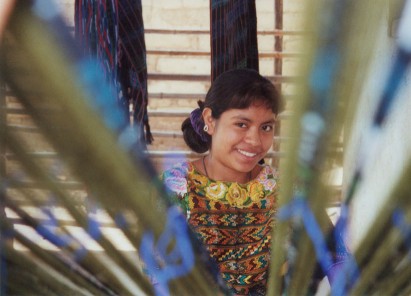

In the year
2001in Santa Cruz La Laguna, a remote, mountaintop village in the Western
highlands of Guatemala, a weaving cooperative was formed.
The cooperative is made up of about twenty plus Kakchikel Mayan women
who call themselves “Las Mujeres Trabajando,” or Working Women.
The Kakchikel, speaking a language of the same name, are one of twenty-three
known ethnic groups in Guatemala. I
had the privilege of getting to know these amazing women and photograph some
of these lovely, hard-working, yet gracious cooperative members.
Through
some funny sign language and lot so of translator help, I learned that the
mission of this cooperative was created to provide a safe container and support
system for the Mayan women to stimulate economic development for themselves
and their community in a country where little is paid for a man’s labor and
almost zero for women’s work. A non-profit
group called “Puente de Amistad,” or Friendship Bridge, stepped up to support
the women in providing small loans for resources, for example, thread for
weaving or small equipment to grind corn.
Puente de Amistad also provides training in simple banking and budgeting
through regular trainings and a monthly support meeting.
Although
I have a great interest in the development element, but it is the art of weaving
element that really is exciting to me. My
passion for hand-woven textiles began in 1997 when I traveled
to Guatemala. I was invited to journey
to the Mayan Kingdom of Guatemala as a volunteer with a non-profit, humanitarian
organization. The specific focus of
our work was to build a sustainable trust-based relationship with a group
of midwives and weavers in a rural village situated in the Western Highlands
of Guatemala. This personal and rich
connection to the weavers is what sparked my interest in traditional hand-woven
textiles and acting as a link for them to reach a wider audience was exciting
and challenging to me. In addition,
the time and effort that is afforded to create a single 25’x 80” piece of
cloth can take at least one month
to create sell for only a pittance locally because that is all local people
can afford.
Another
interesting factor to consider is that the Mayan weavings are central to the
traditions that the Mayans want to preserve.
Generation after generation of Mayan children learned to weave from
their mothers using a back-strap loom. Unfortunately,
that is now changing through exposure to television affordable, accessible
clothing alternatives. More and more
Guatemalans find it more economical and easier to buy secondhand “western”
wear. However, with the undying hope and efforts of many to keep the ancient
wisdom of this tradition thriving, this art will never be lost, it will simply
blossom more fully.
What has moved me most about visiting and getting to know these cultures and people is the self-respect and human dignity that they embody. The women in particular are extremely strong and powerful despite the fact that most are living in financial poverty in U.S. standards. These women, by simply being who they are, are a genuine inspiration by preserving with little more than their talent and sheer passion for what they do: weaver in joyful self-expression.
Lorien
Eck